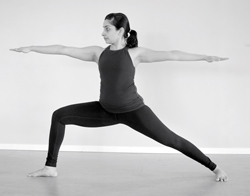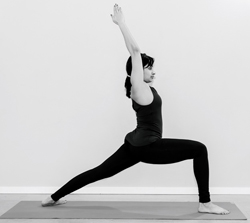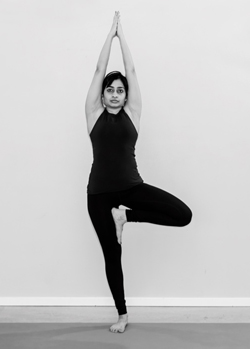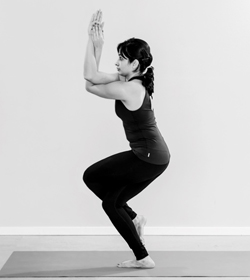There are many categories of yoga poses like standing poses, seated poses, inversions, backward bends, twists, and so on. One such important category is balance postures. These poses can be tricky and demanding as they have holding patterns contrary to our habits. Man was not made to stand on one leg or hand for extended periods of time. That’s why most people give up too easily on balance poses.
But why must we master these poses? Let us look at some of the benefits:
- Improved focus and concentration. In today’s world, we are constantly being pulled in so many different directions that our attention is scattered and short. Learning to hold a pose for an extended duration will teach us to focus our attention on one thing at a time and to concentrate effectively. These poses are excellent for kids too.
- Balance between the two sides of the body. We often have imbalances in our body that we are mostly unaware of. These come to the surface when we attempt balance poses. Unknowingly, we all have one side that is weaker than the other. The aim is to balance both sides of our body equally so one side is not overworked trying to compensate for the weaker side. If left unchecked, these could potentially lead to bad postures, back troubles or injuries.
- Increased body awareness. We forget that we live in our bodies first and then everywhere else. Yet, most of us ignore its wellbeing on a regular basis. When we attempt a balance, we become aware of parts of our body that we don’t think about otherwise—our feet, hands, spine etc. And our intelligence spreads to different parts of our body, thereby increasing the mind-body connection
- Stronger muscles and joints. Most balance poses need strong muscles, healthy joints and good muscle strength and co-ordination. These may not be already present in our body but if we work patiently we can build strength in our muscles, flexibility in our joints and feel a great sense of accomplishment.
We often have imbalances in our body that we are mostly unaware of. These come to the surface when we attempt balance poses
 Let us look at a few preparatory poses that will help strengthen the muscles and increase leg, hip and shoulder flexibility. In most balance poses, we need to have strong leg muscles especially around the ankles and feet. This includes the arches of both feet. When we have collapsed arches, flat feet etc., balance poses become very difficult. Try this simple exercise of pressing the big toe mound, little toe mound and heel down firmly and lift all the toes off the ground. This will instantly lift your arches up. Hold for 10 seconds and release. Try this a few times before starting your balance poses. Strong arches are the key to success in balance poses.
Let us look at a few preparatory poses that will help strengthen the muscles and increase leg, hip and shoulder flexibility. In most balance poses, we need to have strong leg muscles especially around the ankles and feet. This includes the arches of both feet. When we have collapsed arches, flat feet etc., balance poses become very difficult. Try this simple exercise of pressing the big toe mound, little toe mound and heel down firmly and lift all the toes off the ground. This will instantly lift your arches up. Hold for 10 seconds and release. Try this a few times before starting your balance poses. Strong arches are the key to success in balance poses.
Tip:
- If you find that balancing is hard, just stay close to a wall so that you can use your hands against the wall for support till you gain strength and control to balance without support
- Always have a focal point in balance poses. If the eyes move around, the balance will be wobbly
- Be patient and keep working towards it!
Virabhadrasana 2 [Warrior 2]
 This pose helps to strengthen the muscles around the hips especially around the inner thighs, groins and glutes. It also works on the feet and arches. The pose teaches us to ground our legs and feet well, helping us to find that firm foundation that is necessary for all balance poses.
This pose helps to strengthen the muscles around the hips especially around the inner thighs, groins and glutes. It also works on the feet and arches. The pose teaches us to ground our legs and feet well, helping us to find that firm foundation that is necessary for all balance poses.
Technique for Virabhadrasana 2
- Step your feet out to about 3 – 4 feet apart.
- Turn your right foot out to a 90 degrees and keep your left foot straight or slightly turned in
- Bend the right knee to bring the thigh parallel to the ground
- Make sure the knee does not tilt in. It should be directly over the right foot
- Reach the arms out to the sides, in line with the shoulders, keep both arms extending away from the trunk
- Hold the pose for 30 seconds to a minute and slowly return to the starting position
- Repeat on the other side
Virabhadrasana 2 helps us to find that firm foundation that is necessary for all balance poses
>Virabhadrasana 1 [Warrior 1]
 This pose helps to stretch the outer hip muscles, glutes, hamstring and groins. It challenges the balance as the stance is wide and demands full range of extension from the hips and legs. This teaches us proper engagement of our feet.
This pose helps to stretch the outer hip muscles, glutes, hamstring and groins. It challenges the balance as the stance is wide and demands full range of extension from the hips and legs. This teaches us proper engagement of our feet.
Technique for Virabhadrasana 1
- Start with the feet together, inhale and jump the feet about 4 feet apart, with the arms extending to the sides, and the palms facing upward
- Extend the arms overhead, with the elbows straight and bring the palms to touch
- Keeping both legs straight, turn the right foot out 90° and the left foot in about 60°
- Rotate the shoulders, trunk and pelvis to face the right, making sure both sides of the pelvis are facing equally to the right
- On an exhalation, bend the right knee until the shin is perpendicular to the floor and the thigh is parallel to the ground
- Maintain a firm and straight left leg by pressing it down into the mat
- Stay for as long as you can and slowly return to the starting position and repeat on the other side.
Virabhadrasana 1 challenges the balance as the stance is wide and demands full range of extension from the hips and legs
Vrikshasana [Tree pose]
 Helps to tone the muscles of the legs, improves balance, concentration and focus, strengthens the feet and ankles and good for those with a restless mind.
Helps to tone the muscles of the legs, improves balance, concentration and focus, strengthens the feet and ankles and good for those with a restless mind.
Technique for Vrikshasana
- Start with both feet together
- Bend the right knee, hold the right foot, and place the sole of the right foot high on the inside of the left thigh, with toes pointing down
- Keep the left leg straight and steady
- Slowly extend the arms straight overhead, palms together
- Look straight ahead, and hold the pose for 30 seconds to one minute
- Exhale, take the arms down, lower the right foot to the floor, and repeat on the other side
Garudasana [Eagle pose]
 This pose helps to maintain the health of the joints, relieves sciatica and lower back discomfort. Also help gain bladder control.
This pose helps to maintain the health of the joints, relieves sciatica and lower back discomfort. Also help gain bladder control.
Technique for Garudasana
- Start with the feet together, bend the right knee, and wrap the left leg over the front of the right thigh, above the right knee
- Move the left foot behind the right calf so the left shin is against the right calf and
the left big toe hooks just above the inner right ankle - Standing and balancing entirely on the right leg, the left leg is now entwined around the right leg
- Extend the arms forward at shoulder level and bend the elbows so the fingers are pointing up
- Place the right elbow on the left upper arm near the elbow, wrap the right hand around the left by moving the right hand to the right and left hand to the left and join the palms
- Keeping the legs entwined, the left arm is now entwined around the right arm
- To come out of the pose, release the arms and legs to return to the starting position and repeat on the other side.
Garudasana helps maintain the health of the joints besides relieving sciatica and lower back discomfort
Vimanasana [Airplane pose]
 This pose starts to challenge your balance a little more. It strengthens the muscles of the legs and the core, improves concentration, focus and builds hip stability; it also tones spinal muscles.
This pose starts to challenge your balance a little more. It strengthens the muscles of the legs and the core, improves concentration, focus and builds hip stability; it also tones spinal muscles.
Technique for Vimanasana
- Start in Virabhadrasana 1 [mentioned earlier], move the arms out to the sides, with wrists in line with the shoulders
- Move the trunk forward and rotate the back heel off the ground
- Keep the trunk, legs and arms as straight as possible, and slowly shift the weight to the front leg as the left leg rises into the air
- Bring the whole body to a parallel position in relation to the floor, with the back of the head in line with the spine
- Hold the pose for 30 seconds to a minute, then slowly release into Virabhadrasana 1 and return to the starting position before repeating on the other side.
- Pics and model: ARUNDHATI BAITMANGALKAR
This was first published in the March 2016 issue of Complete Wellbeing.
 Spot an error in this article? A typo maybe? Or an incorrect source? Let us know!
Spot an error in this article? A typo maybe? Or an incorrect source? Let us know!
